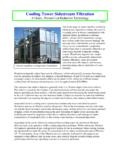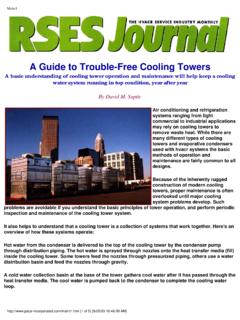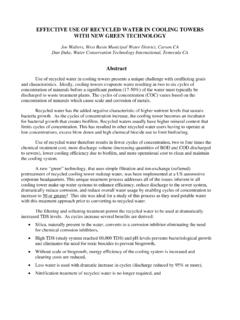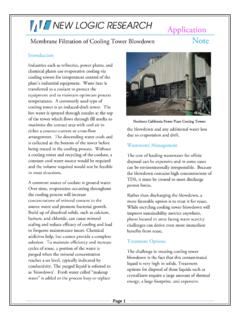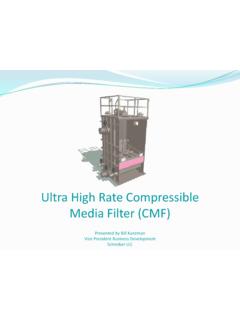Transcription of HVAC WATER TREATMENT OVERVIEW - Herb Stanford
1 1 HVACWATERTREATMENTOVERVIEWHERBERT W. Stanford III, PE 2005 2 Hot WATER and Chilled WATER Systems Chilled WATER and hot WATER systems are closed recirculating WATER systems. For WATER TREATMENT , closed systems have several advantages: There is no loss of WATER in the system (except when a leak occurs) and, thus, no need for make-up WATER . Therefore, deposition or scaling is not a problem. Once filled and entrained air removed, the closed system creates an anaerobic environment that eliminates biological fouling as a problem. Closed systems reduce corrosion problems because the WATER is not continuously saturated with oxygen (an oxidizer) as in open systems.
2 The low temperatures common to hvac systems further reduces the potential for corrosion. WATER TREATMENT to reduce or even eliminate the potential for corrosion is required only when the WATER system is initially filled with WATER or when it is drained and re-filled due to maintenance, repair, or modification. Corrosion in a closed system can occur due to oxygen pitting, galvanic action and/or crevice attack. To prevent these conditions, the shot feed method of chemical TREATMENT is used. With this method, a bypass chemical feeder is used to add TREATMENT chemicals to the system via a one-time shot just after the system is filled with WATER .
3 For the steel and copper mixed metallurgy typical of hvac WATER systems, a molybdate corrosion inhibitor is best, with TREATMENT limits of 200-300 ppm recommended. Condenser WATER Systems For open condenser WATER systems, the WATER TREATMENT issue becomes much more involved and a specialized WATER TREATMENT program is required to prevent or control deposition (scaling), corrosion, and microbiological fouling of cooling towers, condensers, and piping. As a portion of the condenser WATER flow is lost by evaporation (approximately of the flow rate per degree of temperature range) through the cooling tower, the concentration of dissolved solids increases since solids are left behind as the liquid evaporates.
4 Make-up WATER , which is added to the condenser WATER system to offset the evaporation losses, will add dissolved minerals at a lower concentration level than the condenser WATER and, thus, some equilibrium concentration level will be maintained. However, if this equilibrium concentration level is high enough that can deposition occur, a program to control solids concentration at a lower level is required. The concentration of dissolved solids can be reduced by adding more make-up WATER , which has a lower concentration, to the condenser WATER , which has a higher 3 concentration.
5 However, to add WATER to the system, an equal amount must be removed from the system by blowdown, the intentional dumping of condenser WATER to drain. For corrosion control, condenser WATER pH must be maintained between 4 and 10 and, in most cooling tower WATER TREATMENT programs, the desirable range for pH is between 8 and 9 in order to WATER alkalinity to a reasonable level (400 ppm or less). However, in metal towers, a pH of is preferred to help prevent white rust corrosion. Therefore, at least for most metal cooling towers, the ideal pH range is WATER hardness and alkalinity is a function of the hardness and alkalinity of make-up WATER , the amount of evaporation and drift loss from the cooling tower operation, and the blowdown to proposed to yield the desirable pH to prevent both deposition and corrosion.
6 The term cycles of concentration defines the ratio of the desired concentration of dissolved solids in the condenser WATER to the concentration of dissolved solids in the make-up WATER , as follows: Cycles (of Concentration) = Dissolved Solids (ppm) in Blowdown / Dissolved Solids (ppm) in Make-up This relation can be express in terms of WATER flow by the following equation: Cycles (of Concentration) = MU / BD where MU = total make-up WATER flow, which is the sum of evaporation + blowdown, gpm BD = blowdown flow, gpm MU in this equation can be replaced with the value (E + BD), where E is the evaporation rate, and rearranged to yield the following relationship: BD = E / (Cycles 1) Since drift WATER loss is not included in these calculations, the actual required BD flow can be reduced by the amount of drift loss from the tower (about ) There are two ways of controlling blowdown in an hvac cooling tower system.
7 Constant blowdown with manual adjustment based on periodic WATER hardness analysis is the simplest method. However, since the amount of blowdown is constant, the loss in WATER and WATER TREATMENT chemicals is high and this really represents the most expensive approach. Controlled blowdown based on continuous monitoring of the WATER hardness as indicated by its conductivity. Automatic control minimizes the waste of WATER and WATER TREATMENT chemicals and is the preferred method. 4 The amount of make-up WATER is reduced significantly as the number of cycles is increased from 2 to 6.
8 However, there is only a further 5% reduction in make-up WATER as the number of cycles is increased from 6 to 10, and only a further 2% reduction as it is increased to 20. Therefore, in most cooling tower applications, cycles of concentration is maintained between 5 and 10 and deposition inhibitors are added as necessary. While lower cycles represent loss of more WATER and TREATMENT chemicals, the amount of TREATMENT chemicals required tends to go down with cycles, and 5-10 cycles usually represents a good balance point. In these cases, chemical TREATMENT , the addition of deposition inhibitors to the WATER system, becomes necessary to augment blowdown.
9 The most common scale inhibitors used in condenser WATER systems are posphonates, which are organic phosphate compounds, such as HEDP, which function by adsorption on the crystals as they form and prevent them from attaching to metal. Thus, these crystals precipitate out of solution, usually in the tower basin. Metal corrosion occurs as a result of galvanic action at a negatively charged pole or site on the metal surface. Both anodes, negatively charged sites, and cathodes, positively charged sites, can be created on the metal due to impurities in the metal, localized stress, metal grain size or composition differences, or even scratches on the metal surface.
10 Due to the differences in charges, there is an electrical potential between the anode and cathode and an electrical current (electrons) flows from anodes to cathodes, using the surrounding WATER as a conductor or electrolyte. Corrosion is the loss of metal; it literally dissolves . Corrosion can exhibit two characteristics depending on the underlying reason for the anodic and cathodic sites. General corrosion is wide spread and is caused, usually, by impurities in the metal or characteristics of the metal or its environment that results in an overall fouling of the metal surface.


